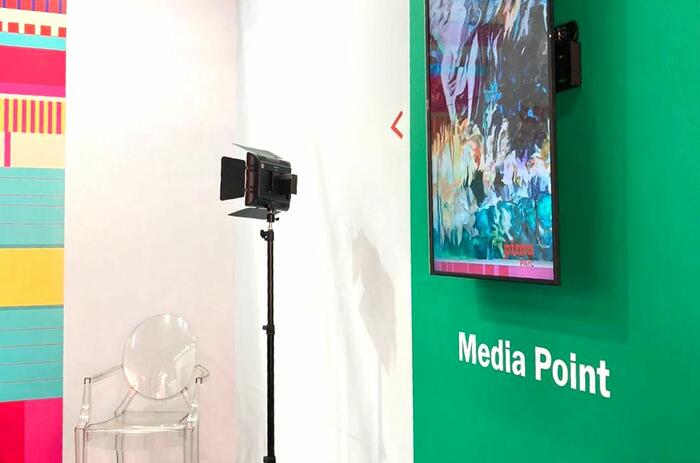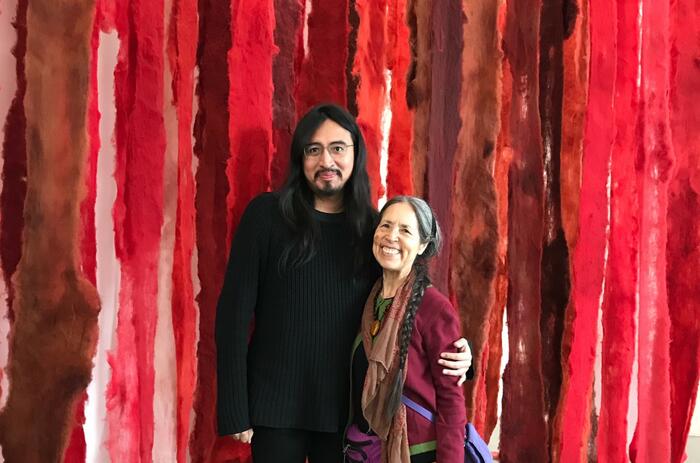CONTEMPORARY TRADITION - TEXTILE ART AT PINTA PARC 2022
As a novelty, this year Pinta PArC presents a new space with a leading role marked by the textile art of Tiodoro Pacco. Institutionally and with the curatorship of Jerson Ramirez, the aim is to recover, highlight and celebrate the traditional techniques and artistic work of the region. The space is thus dedicated to the exploration of memory, the transmission of cultural valuesand the examination of the processes and formats that are interwoven in the Peruvian artistic identity.

In its space at Pinta PArC, the exhibition is made up of works that are part of cultural promoter Armando Andrade’s collection. These large format works exhibit geometric designs in black and white. Arranged in patterns reminiscent of op art works, the works have a particular dynamism where modernity is interwoven with the warm character of the textile fibers.
"Peru is internationally recognized for its textile tradition and diversity," shares Jerson Ramirez, curator of the exhibition. “Each region is characterized by a certain technique, material, color and shape. In this sense, the textiles can be understood as a sort of portrait of the territory in which they were created. The town of Palca, in Puno, stands out for its alpaca farming tradition. For this reason, it is not surprising that the artisans of this community have learned to dominate the fiber of these animals and elaborate complex and colorful textile pieces that they integrate into their daily work. One of the greatest representatives is Don Tiodoro Pacco, who learned the weaver's trade in his teens in his father's workshop. Possessor of a curious spirit, Don Tiodoro carries out a constant technical and material exploration that allows him to innovate the local tradition and elevate his work to the category of art.”
-
Obras por Tiodoro Pacco. Colección Armando Andrade. Fotos por Jerson Ramirez.
-
Obras por Tiodoro Pacco. Colección Armando Andrade. Fotos por Jerson Ramirez.
-
Obras por Tiodoro Pacco. Colección Armando Andrade. Fotos por Jerson Ramirez.
-
Obras por Tiodoro Pacco. Colección Armando Andrade. Fotos por Jerson Ramirez.
As a sign of support and encouragement, Pinta PArC highlights the work of the AMANO Museum and its collection of Pre-Columbian Textile Art.
The institution was born out of the initiative of the successful Japanese businessman, Yoshitaro Amano, to protect the cultural heritage of Peru from destruction and looting. In his numerous travels around the country, Mr. Amano was able to see the objects left behind by tomb raiders and, being a person of great culture, he understood their importance. For this reason, he dedicated a large part of his time and funds to recovering and preserving abandoned objects in the deserts of the coast, exhibiting them in his house in Miraflores.
In 1964, he founded the Amano Museum, one of the first buildings designed in Peru to function as a museum. After its foundation, it was recognized as one of the most important exhibition spaces for Peruvian textile art and a bridge for cooperation between Japanese and Peruvian researchers. Fifty years later, the Amano family made the decision to remodel the museum in keeping with its founder's tradition of service and research. The new concept offers a modern exhibition approach focused entirely on the world of pre-Columbian textiles, under modern conditions of exhibition and conservation.
Jerson Ramirez (Lima, 1993) has a Bachelor of Arts from the Universidad Nacional Mayor de San Marcos. He has worked in the area of Educational Curation of the Museo de Arte de Lima in the development of educational programs and in the area ofVisual Arts of the Department of Culture and Tourism of the Municipality of Miraflores as coordinator of the area and as coordinator of Temporary Exhibitions at the Luis Miró Quesada Garland Room. He also served as curator and cultural manager of the Amano Museum. Since 2019 he has worked on the enhancement of different private collections, archives and legacies of national artists. In parallel, since 2017, he has developed cultural management, curatorship, research and museography projects for national and international exhibition spaces. His line of research focuses on the critical study of art and art institutions in Lima in the 1980s. He has been a member of the Association of Curators of Peru since 2018.
“I conceive curatorship as a task that, beyond giving theoretical support to artistic work, can generate meeting, dialogue and learning spaces through a sensitive and playful experience. To achieve this, I consider that research on the subject addressed by the artist is as important as knowing and understanding his motivations and concerns. In this way, it is possible to create a visual narrative, materialized as an installation, in which the works are related to the dimensions, shapes, colors, lights and sounds of the space that hosts them. The correct selection and combination of these elements can transmit and/or awaken various sensations and emotions in the visitor, activating the senses and generating reflections and knowledge through them.”
-
Obras por Tiodoro Pacco. Colección Armando Andrade. Fotos por Jerson Ramirez.
-
Obras por Tiodoro Pacco. Colección Armando Andrade. Fotos por Jerson Ramirez.
-
Obras por Tiodoro Pacco. Colección Armando Andrade. Fotos por Jerson Ramirez.
-
Obras por Tiodoro Pacco. Colección Armando Andrade. Fotos por Jerson Ramirez.
-
Obras por Tiodoro Pacco. Colección Armando Andrade. Fotos por Jerson Ramirez.
Tiodoro Pacco Choque is a textile artist from the town of Palca, Puno. His father taught him the textile trade in his teens; from him he learned to use the stake loom and the pedal loom, tools that allow him to perpetuate the local tradition. In 2003 he founded, together with his wife Juana Zea, the Association of Artisans Las Vicuñas de Palca. The organization brings together 15 families of artisans and promotes their work at national and international fairs. Tiodoro carries out constant research and technical, material and formal exploration, which has led him to give training talks in other Latin American countries. Thanks to his active participation in the editions of the Ruraq Maki fair, the quality of his artistic work began to be recognized by different local collectors.















